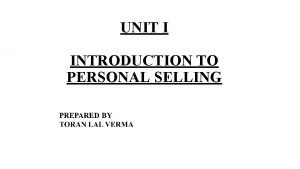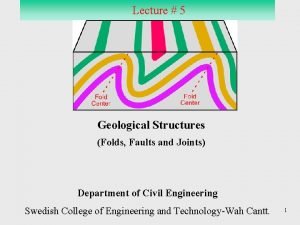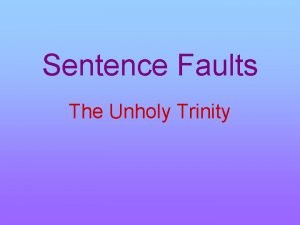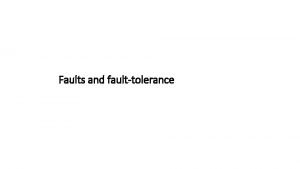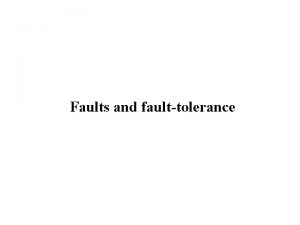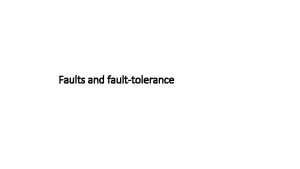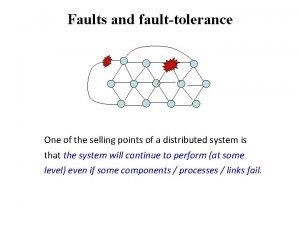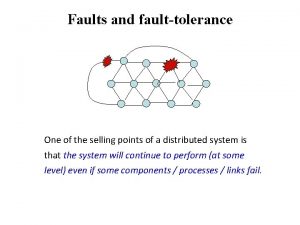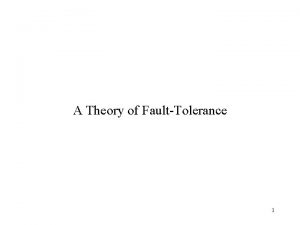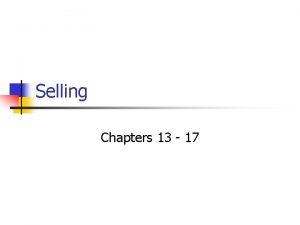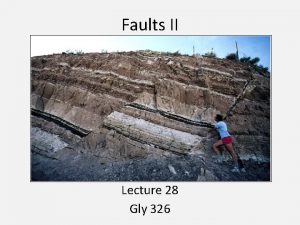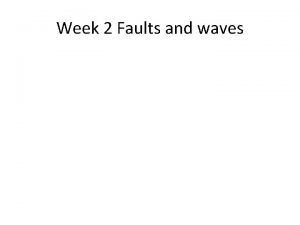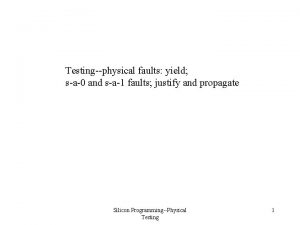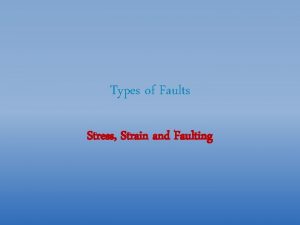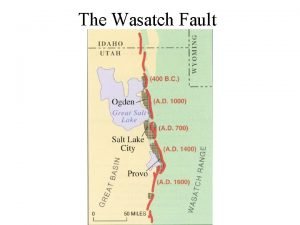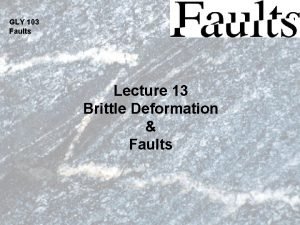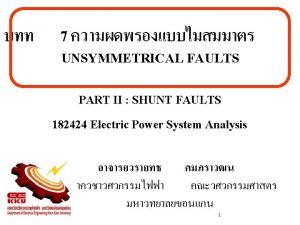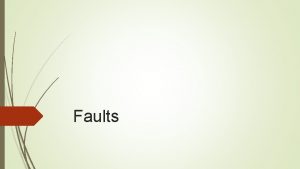Faults and faulttolerance One of the selling points



















- Slides: 19

Faults and fault-tolerance One of the selling points of a distributed system is that the system will continue to perform (at some level) even if some components / processes fail.

Cause and effect • Study examples of what causes what. • We view the effect of failures at our level of abstraction, and then try to mask it, or recover from it. • Reliability and availability are closely related to MTBF (Mean Time Between Failures) and MTTR (Mean Time To Repair)

Classification of failures Crash failure Security failure Omission failure Temporal failure Transient failure Byzantine failure Software failure Environmental perturbations

Crash failures Crash failure = the process halts. It is irreversible. In synchronous system, it is easy to detect crash failure (using heartbeat signals and timeout). But in asynchronous systems, it is never accurate, since it is not possible to distinguish between a process that has crashed, and a process that is running very slowly. Some failures may be complex and nasty. Fail-stop failure is a simple abstraction that mimics crash failure when program execution becomes arbitrary. Implementations help detect which processor has failed. If a system cannot tolerate fail-stop failure, then it cannot tolerate crash.

Omission failures Message lost in transit. May happen due to various causes, like – – Transmitter malfunction Buffer overflow Collisions at the MAC layer Receiver out of range

Transient failure (Hardware) Arbitrary perturbation of the global state. May be induced by power surge, weak batteries, lightning, radiofrequency interferences, cosmic rays etc. Not Heisenberg (Software) Heisenbugs are a class of temporary internal faults and are intermittent. They are essentially permanent faults whose conditions of activation occur rarely or are not easily reproducible, so they are harder to detect during the testing phase. Over 99% of bugs in IBM DB 2 production code are nondeterministic and transient (Jim Gray)

Software failures Coding error or human error On September 23, 1999, NASA lost the $125 million Mars orbiter spacecraft because one engineering team used metric units while another used English units leading to a navigation fiasco, causing it to burn in the atmosphere. Design flaws or inaccurate modeling Mars pathfinder mission landed flawlessly on the Martial surface on July 4, 1997. However, later its communication failed due to a design flaw in the real-time embedded software kernel Vx. Works. The problem was later diagnosed to be caused due to priority inversion, when a medium priority task could preempt a high priority one.

Software failures Memory leak Processes fail to entirely free up the physical memory that has been allocated to them. This effectively reduces the size of the available physical memory over time. When this becomes smaller than the minimum memory needed to support an application, it crashes. Incomplete specification (example Y 2 K) Year = 09 (1909 or 2009 or 2109)? Many failures (like crash, omission etc) can be caused by software bugs too.

Temporal failures Inability to meet deadlines – correct results are generated, but too late to be useful. Very important in real-time systems. May be caused by poor algorithms, poor design strategy or loss of synchronization among the processor clocks

Environmental perturbations Consider open systems or dynamic systems. Correctness is related to the environment. If the environment changes, then a correct system becomes incorrect. Example of environmental parameters: time of day, network topology, user demand etc. Essentially, distributed systems are expected to adapt to the environment A system of Traffic lights Time of day

Byzantine failure Anything goes! Includes every conceivable form of erroneous behavior. The weakest type of failure Numerous possible causes. Includes malicious behaviors (like a process executing a different program instead of the specified one) too. Most difficult kind of failure to deal with.

Security problems Poor security can lead to failure. Code or data may be corrupted by security attacks. In wireless networks, rogue nodes with powerful radios can sometimes impersonate for good nodes and induce faulty actions.

Specification of faulty behavior (Most faulty behaviors can be modeled as a fault action F over the normal action S. This is for specification purposes only) program example 1; define x : boolean (initially x = true); {a, b are messages); do {S}: x send a {specified action} [] {F}: true send b {faulty action} od aaaabbaaaaaaa…

Fault-tolerance F-intolerant vs F-tolerant systems A system that tolerates failure of type F Four types of tolerance: tolerances - Masking - Non-masking - Fail-safe - Graceful degradation faults

Fault-tolerance P is the invariant of the original fault-free system Q represents the worst possible behavior of the system when failures occur. It is called the fault span. Q is closed under S or F. Q P

Fault-tolerance Masking tolerance: P = Q (neither safety nor liveness is violated) Q Non-masking tolerance: P Q (safety property may be temporarily violated, but not liveness). Eventually safety property is restored. P

Classifying fault-tolerance Masking tolerance. Application runs as it is. The failure does not have a visible impact. All properties (both liveness & safety) continue to hold. Non-masking tolerance. Safety property is temporarily affected, but not liveness. Example 1. Clocks lose synchronization, but recover soon thereafter. Example 2. Multiple processes temporarily enter their critical sections, but thereafter, the normal behavior is restored. Backward error-recovery vs. forward error-recovery

Backward vs. forward error recovery Backward error recovery When safety property is violated, the computation rolls back and resumes from a previous correct state. time rollback Forward error recovery Computation does not care about getting the history right, but moves on, as long as eventually the safety property is restored. True for self-stabilizing systems.

Classifying fault-tolerance Fail-safe tolerance Given safety predicate is preserved, but liveness may be affected Example. Due to failure, no process can enter its critical section for an indefinite period. In a traffic crossing, failure changes the traffic in both directions to red. Graceful degradation Application continues, but in a “degraded” mode. Much depends on what kind of degradation is acceptable. Example. Consider message-based mutual exclusion. Processes will enter their critical sections, but not in timestamp order.
 Sales types
Sales types Inside order takers
Inside order takers Straddle positioning example
Straddle positioning example Point of difference and point of parity
Point of difference and point of parity One face one voice one habit and two persons
One face one voice one habit and two persons Folds faults and joints
Folds faults and joints Normal reverse and transform faults
Normal reverse and transform faults Make your own folds and faults
Make your own folds and faults Catch the little foxes
Catch the little foxes One god one empire one emperor
One god one empire one emperor One one one little dog run
One one one little dog run One king one law one faith
One king one law one faith One empire one god one emperor
One empire one god one emperor Ford one plan
Ford one plan See one do one teach one
See one do one teach one See one, do one, teach one
See one, do one, teach one See one do one teach one
See one do one teach one Asean tourism strategic plan
Asean tourism strategic plan Graphic organizer with the aims of la liga filipina
Graphic organizer with the aims of la liga filipina Failure sentence
Failure sentence

